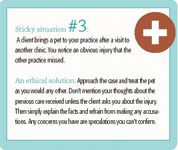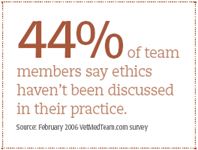Ethics: Answers to your tough questions
Here are five ethical dilemmas, complete with guidelines for making decisions that keep you on solid moral ground.
It's closing time at ABC Animal Clinic. You're counting the change in the cash drawer when you notice your co-worker, Jenny, hanging around the food display. Without blinking, she grabs a few bags of dental treats and stuffs them in her purse. You're pretty sure she didn't pay. What should you do?

When you work at a practice, you likely face tough ethical situations every day. Perhaps you disagree with your practice's euthanasia policy or you witness a pet owner handling his rottweiler more roughly than necessary. How should you respond? Ask three people and you might get three different answers. Ethics are often a very personal—and potentially inflammatory—issue. Here are some guidelines you can use to make thoughtful, ethical decisions in every situation.
1. Choose the right practice
Does your practice have written ethical protocols, and do the practice owners share these with the team? If your team shares the same ideals, you'll face fewer conflicts later. Does it really matter if you don't agree? Absolutely, says Bernard Rollin, Ph.D., a bioethicist and professor of philosophy, biomedical sciences, and animal sciences, and a University Distinguished Professor at Colorado State University. If doctors and team members don't have practice guidelines, they're forced to rely on their personal principles, which may not match the ideals of the people they work with. The good news: You're in a great position to establish ethical protocols and procedures and help create guidelines for appropriate conduct for your practice.

"It's your responsibility to find a practice with similar ethical principles," says Sheila Grosdidier, RVT, a Firstline Editorial Advisory Board member and a consultant with VMC Inc. in Evergreen, Colo. "When you start on the same page, you eliminate many of the inevitable conflicts that compromise patient care." So talk it out, and get specific. You probably all agree it's bad to hit an animal, but what's the appropriate level of restraint for an aggressive dog?
It's also a good idea to review the ethical standards established in your employee handbook. If you don't have an employee handbook, you may need to create one. "Practices need to lay out their expectations of team members," says Karen Felsted, CPA, MS, DVM, CVPM, a consultant with Gatto McFerson CPAs in Santa Monica, Calif. "And an employee handbook is one tool a practice can use for communicating these expectations." The handbook should outline policies for attendance, vacation time, travel, performance evaluation, continuing education, and promotions. Many employee handbooks also address certain conduct and care principles, such as employees' behavior during company time, non-discrimination, and sexual harassment.
For example, your employee handbook might outline a policy that team members who purchase products from the practice must ask another employee to ring up the sale. Then, if you notice Jenny's planning to take home some dental treats, you can ask, "Can I ring that up for you?" If she says no, you can gently remind her about your practice's policy and offer again to ring up her purchase.
The topics often not covered in an employee handbook are the day-to-day issues and general practice behaviors, which are usually determined by the natural dynamic of the current team. These behaviors include how team members treat one another and clients. A solid code of ethics will help direct these behaviors and ensure everyone in the practice starts with the same ethical framework, says Patrick Navarre, RVT, Executive Director of the National Association of Veterinary Technicians in America. It won't provide answers for every ethical dilemma, he adds, but it will provide guidance to help you act in ways that benefit everyone—the patient, the client, the team members, and the practice. (Check out NAVTA's Code of Ethics at www.navta.net.)
To build a solid ethical framework, establish principles that address the different components of practice life, including medical, business, and workplace ethics. For example, you may discuss acceptable and unacceptable medical procedures, charging clients appropriately, and suitable delegation of responsibilities, Dr. Felsted says.
"To get started, research other professions' codes of ethics and how they direct members to a common goal or objective," Navarre says. "See what concepts you like and adapt them."
Once you establish your practice's ethical principles, the policies and protocols that support your standard level of conduct and care easily fall into place, Grosdidier says.
2. Watch for red flags
Whether you're confronted with an ethical quandary or merely a bystander, you face a difficult question—what's a breach of ethics? One way to decide is to consider your responsibilities. For example, Rollin says you have an obligation to clients to keep contracts, tell the truth, explain their options, charge fairly, and maintain confidentiality. Your peers can expect you to uphold and protect the profession and treat other team members respectfully. Society may expect you to report diseases and question the safety of animal products and supplies. You're also obligated to consider such issues as how many hours you should work and how much time you need to spend to provide good care for each animal. Finally, consider your obligations to pets regarding such topics as pain control and euthanasia. If you can rationally and logically identify a right that's been violated, you've found a breach of ethics.

Rollin suggests developing a network of colleagues outside your practice to use as a sounding board when situations get sticky. These peers should be able to offer alternative explanations and solutions and give you a more objective perspective.
3. Weigh your response
Once you've identified a breach of ethics, your instinct may be to act. Take a deep breath and consider your options again, Rollin says. "There are few situations where you're forced to choose your ethical stance and act immediately," he says. "And those situations are usually a matter of life and death. In most cases, you have time to think through all of the facts and act minutes, hours, or days later, when you're more confident."

If you're directly involved, try to buy yourself time and engage your supervisor. For example, if you confronted Jenny about the treats in her purse and she refused to follow your practice's payment policy, you might say, "I'm sorry, Jenny, but I'm not comfortable with this situation. I think we need to discuss this with the practice manager." Then, at the next opportunity, explain the situation to the practice manager and allow her to address the policy violation with Jenny.
Remember, it's always better to err on the side of caution. So if you're handling a difficult situation by yourself, keep your manager informed and explain how you're handling the situation and the actions you're taking to protect the patient, yourself, and the practice.

If you witness a questionable situation, Grosdidier recommends asking questions and giving colleagues the benefit of the doubt. "Extend the same courtesies you would want given to you," she says. "You may not know all the facts, and rumors aren't a reliable source of information. So make sure you know the whole truth."
For example, if you heard that Jenny took treats without paying, you might approach her with the rumor. If Jenny says, "Yes, but everybody does it," Rollin suggests you respond by saying, "This puts me in a very bad position." This lets Jenny know you're preparing to take action, and it may be enough to make her stop. "Although most people don't like confrontation, talking to the person directly can be the healthiest way to handle the situation," Rollin says.
4. Know when to report an offense
So you've questioned and confirmed the unethical incident, and now you're not sure you want to report it. "Usually, it's because we're not sure whether we'll be commended or chastised for our actions," says Rollin. "In some cases, we applaud whistle-blowers, and in others, we call them nasty names."
If you're hesitating—or afraid of being labeled a tattler—consider the severity and frequency of the offense and your intentions for reporting it. Dr. Felsted says, "Ask yourself whether the behavior violates the practice's ethical principles or your own."

In the end, there are no hard and fast rules. But there will be offenses so severe that you immediately report them to the appropriate authorities. Other, less severe, offenses may only require a manager to remind the team member about your practice's policies to stop the unethical behavior.
When you're compelled to report an offense, such as animal abuse, your local human organization is often your first line of defense, Rollin says. For ethical offenses that break the law, you may turn to law enforcement agencies. Just be sure you possess all of the facts before you make a potentially damaging accusation.
In some situations, there's no obvious right answer. "This is the time to rely on your personal ethics," Dr. Felsted says. "Ask yourself, 'Why am I making this decision? Is it for the right reasons? Is there a better way to address the unethical behavior?'"
It's easy to pass the buck or ignore a situation, but Dr. Felsted says everyone's morally obligated to consider the facts and address unethical behavior, regardless of their role in the practice. You may not always be able to stop the unethical behavior, but you can raise red flags for others or influence practice policy changes.
5. Plan team training
To make sure you're ready to tackle the next tricky situation, plan some team training to discuss your practice's guidelines. "Consider breaking ethics training into bite-size, more digestible pieces, and start with the more black-and-white, less threatening principles," says Dr. Felsted. "For example, start with something you all agree on: your practice isn't going to charge clients for procedures you don't do. Then move on to tougher topics that will take more time and discussion."

Case studies offer a good approach, Dr. Felsted says, because they illustrate how you'll implement the practice's principles. "For instance, you can use case studies as a springboard for discussion in your staff meetings," she says. "Consider devoting 10 minutes of every staff meeting to an ethics topic." Role-playing will help you brainstorm responses.

"Ultimately, veterinary ethics is about making sure clients and their pets are treated fair and treated right," Dr. Felsted says. "And I think every team member at every practice wants to see that happen."